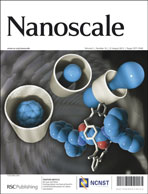A 25-atom gold nanocluster capped with an achiral thiolate exhibits no chiroptical signals in circular dichroism (CD) measurements. Herein, we report a systematic study on the effects of the chiral environment on the CD response from the Au25 metal core. We found that Au25(SC2H4Ph)18−TOA+ dissolved in a chiral solvent did not give rise to a CD response, nor did Au25(SC2H4Ph)18− when associated with a chiral counterion (e.g., (−)-N-dodecyl-N-methylephedrinium, DME+). Both scenarios imply that the interaction of the chiral counterion (or chiral solvent molecules) with the achiral Au25(SC2H4Ph)18− nanocluster is not strong enough to induce CD signals from the metal core. In contrast, when the metal core is capped with chiral ligands (i.e., Au25(SCH2C*H(NH2)CH2Ph)18), strong CD signals in the visible wavelength range were observed. Thus, the induction of CD signals by surface chiral ligands is much stronger than that by the external chiral environment (including the chiral solvent or counterion). This work reveals some further insight into the origin of the chiroptical response of the Au nanoclusters. These chiral nanoclusters hold potential for practical applications in bioconjugation, sensing, and chiral catalysis.

You have access to this article
 Please wait while we load your content...
Something went wrong. Try again?
Please wait while we load your content...
Something went wrong. Try again?


 Please wait while we load your content...
Please wait while we load your content...